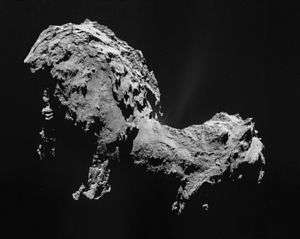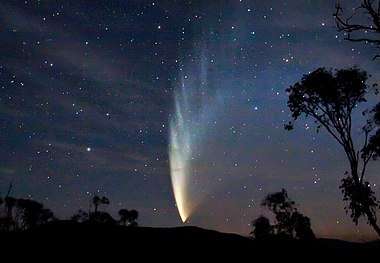Comet seeker
A comet seeker is a type of small telescope adapted especially to searching for comets: commonly of short focal length and large aperture, in order to secure the greatest brilliancy of light. This style of telescope was used to discover the asteroid 9 Metis in the 1848.
- Design


A comet seeker telescope is a type of optical device that is known for having a short focal length but a wide field of view.[1]
- Examples
A comet seeker with about 3.9 inch aperture was installed at the United States Naval Observatory in 1843, and later transferred to the Smithsonian Museum in 1866.[1] It had an aperture of 4 inches (10.2 cm) and was made by Utzschneider & Fraunhofer in Munich.[2] This was operated as part of suite of several other instruments including a larger refractor on an equatorial mounting, a meridian transit, mural circle, etc.[2]
Markree Observatory added a 3-inch aperture Comet Seeker on an equatorial mount by Ertel.[3] It was ordered in 1842, and in place until 1874.[3]
The Markree Comet Seeker was used to discover 9 Metis in April 1848.[4] It was discovered by Edward Cooper's assistant Andrew Graham, who worked at that observatory until 1860.[3][4] Graham also observed and sketched the Orion nebula with this Ertel Comet seeker.[4]
A 8.6 cm (~3.39 in.) aperture Comet Seeker was used, with some customizations, to produce the Bonner Durchmusterung star catalog from Bonn Observatory, in the 19th century.[5]
In 1866 a Comet Seeker telescope of 18 centimetres (7.1 in) aperture by Martin was acquired by the Marseilles Observatory in France.[6]
See also
References

- "Utzschneider & Fraunhofer, Merz & Mahler Refracting Telescope (Comet Seeker)". Smithsonian Institution. Retrieved 2019-10-01.
- The General History of Astronomy. Cambridge University Press. 1900. ISBN 9780521242561.
- "1884Obs.....7..329D Page 329". adsabs.harvard.edu. Retrieved 2019-10-01.
- Steinicke, Wolfgang (2010-08-19). Observing and Cataloguing Nebulae and Star Clusters: From Herschel to Dreyer's New General Catalogue. Cambridge University Press. ISBN 9781139490108.
- "1987JBAA...97..339H Page 339". adsabs.harvard.edu. Retrieved 2019-10-12.
- Lequeux, James (2013-03-15). Le Verrier—Magnificent and Detestable Astronomer. Springer Science & Business Media. ISBN 9781461455653.